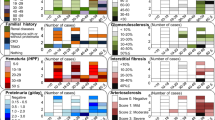Abstract
The glomerular basement membranes (GBM) were measured in 264 patients with recurrent and persistent hematuria (152 males, 112 females), 47 patients with minimal change nephrotic syndrome (26 males, 21 females), and 91 patients with focal segmental glomerular sclerosis and nephrotic syndrome (55 males, 36 females). The average number of glomeruli measured was 2.5 per case. Analysis of the data showed GBM thickness to be significantly greater in males (n=233) than in females (n=169) (Student'st-test,P<0.01). There was no difference in GBM thickness between the two groups of nephrotics; the data were subsequently combined and the group referred to as idiopathic nephrotic syndrome. There was also no difference in GBM thickness among the immunofluorescence-defined subcategories of recurrent hematuria, and these groups were combined. GBM thickness was significantly greater in the idiopathic nephrotic syndrome than in recurrent hematuria (Kruskal-Wallis H test,P O=<0.001). Analysis of the data showed, in both conditions, a gradual increase with age throughout the span of the study (1–69 years). Regression analysis of GBM thickness and age in recurrent hematuria showedR O=0.43 andP O=<0.001, in idiopathic nephrotic syndromeR O=0.61 andP O=<0.001. The differences between nephrotic syndrome and recurrent hematuria may be based on the inclusion in the recurrent hematuria group of patients with genetically thin GBM; they may also be based on the inclusion in the idiopathic nephrotic syndrome group of patients with subendothelial thickening, a relatively frequent occurrence. These data also indicate that GBM thickness continues to increase throughout life in patients with idiopathic nephrotic syndrome and recurrent hematuria, perhaps as part of the normal aging process.
Similar content being viewed by others
References
Bloom PM, Hartmann JF, Vernier RL (1959) An electron microscopic evaluation of the width of normal glomerular basement membrane in man at various ages. Anat Rec. 133: 251
Osawa G, Kimmelstiel O, Seiling V (1966) Thickness of glomerular basement membranes. Am J Clin Pathol 45: 7–20
Steffes MW, Barbosa J, Basgen JM, Sutherland ER, Najarian JS, Mauer SM (1983) Quantitative glomerular morphology of the normal human kidney. Lab Invest 49: 82–86
A Report from the International Study of Kidney Disease in Children (1980) Clinical pathological correlations in recurrent and persistent hematuria syndromes (RPHS). Fifth International Pediatric Nephrology Symposium, Philadelphia, 6–10 October. Pediatr Res 14: 995
A Report of the International Study of Kidney Disease in Children (1978) Nephrotic syndrome in children: prediction of histopathology from clinical and laboratory characteristics at time of diagnosis. Kidney Int 13: 159–165
Østerby Hansen R (1965) A quantitative estimate of the peripheral glomerular basement membrane in recent juvenile diabetes. Diabetologia 1: 97–100
Author information
Authors and Affiliations
Rights and permissions
About this article
Cite this article
Shindo, S., Yoshimoto, M., Kuriya, N. et al. Glomerular basement membrane thickness in recurrent and persistent hematuria and nephrotic syndrome: correlation with sex and age. Pediatr Nephrol 2, 196–199 (1988). https://doi.org/10.1007/BF00862590
Received:
Revised:
Accepted:
Issue Date:
DOI: https://doi.org/10.1007/BF00862590




